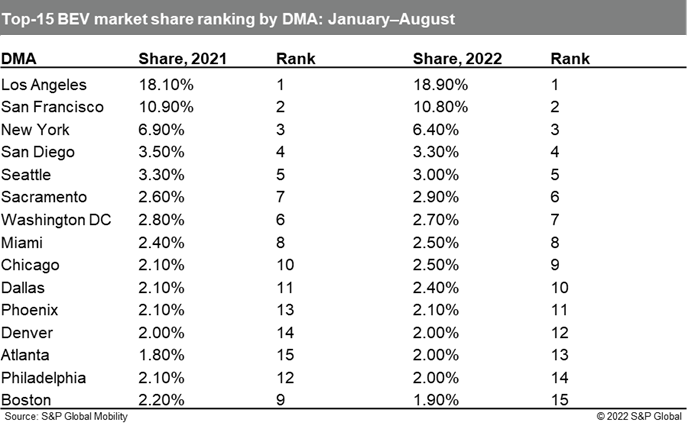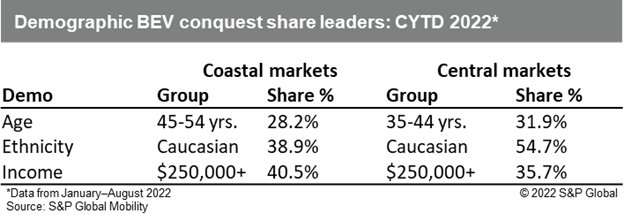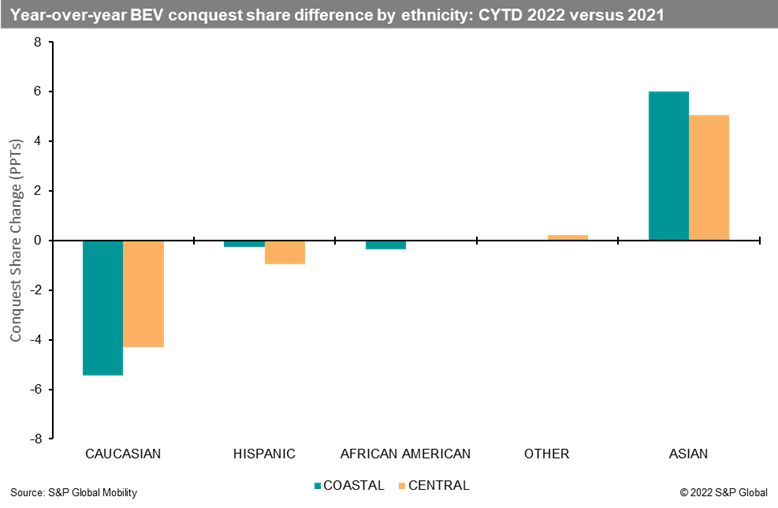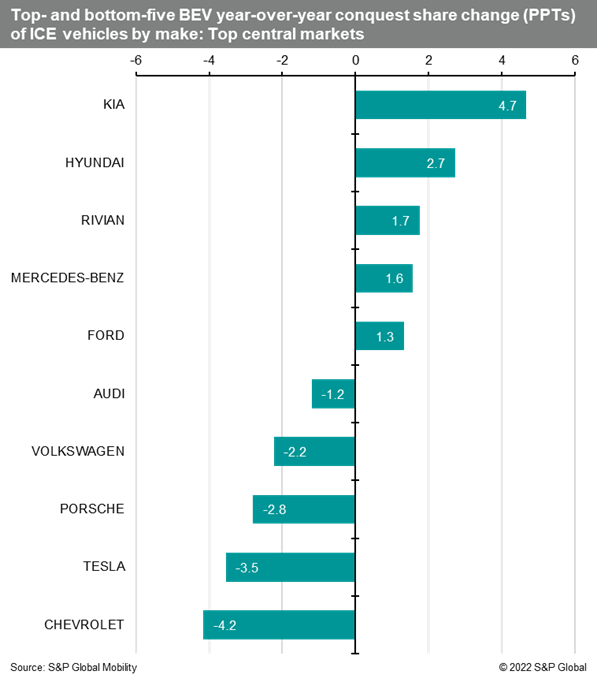Tag: Santa Clara
The Week’s 10 Biggest Funding Rounds: Health And Biotech Land Big Week As DispatchHealth Leads
2023: Welcome to the Danger Zone
Zappar Presents AR Pioneers 2022
When will the heartland embrace electric vehicles?
As national charging infrastructure is created, coastal America still dominates EV registrations
With USD5 billion in electric vehicle charging network funds (and more to come) available under the Bipartisan Infrastructure Law, states are lining up for their share of federal largesse.
However, outside of the large coastal cities, retail registrations of EVs have yet to take hold, according to new analysis from S&P Global Mobility. The top-eight EV markets in the US are all in coastal states, and represent 50.5% of total EV registrations in 2022. The greater Los Angeles and San Francisco metropolitan areas* alone account for nearly one-third of total share of the US EV market.
While the 22 heartland states** represent 27.1% of total US
vehicle retail sales through August, their representation in EV
adoption has remained stagnant from 2021 into this year—at a
tepid 15.5% share. Only Colorado and Nevada (and to a minuscule
extent, Utah) outpunch their overall retail share in EV
representation, according to S&P Global Mobility data.

Coastal dominance
It is no surprise that California, a leader in green initiatives and EV adoption, dominates the top of share rankings. Greater Los Angeles (18.9% share of total EV sales), the San Francisco Bay Area (10.8%), and San Diego (3.3%) saw no change in their top-five position year-over-year when comparing rankings for calendar year to date (CYTD: January-August) 2022 versus 2021, while Sacramento improved its position from the previous year.
Additionally, of the 13 markets that increased share for CYTD 2022 versus 2021, most were in the "smile" states***, including Atlanta, Austin, Dallas, and Houston. Only Chicago, Las Vegas, Missoula, and Salt Lake City represented share gains in big cities of "Heartland" states. Not all coastal markets are guaranteed share gains; New York and Boston registered slight EV share declines this year.

"BEV market share control on the two coasts is attributed to
their higher mix of early adopters compared to buyers in middle
America," said Tom Libby, associate director of Loyalty Solutions
and Industry Analysis at S&P Global Mobility. "Their
demographic profile is more in sync with the traditional BEV buyer
than the middle-American profile."
But Libby sees potential in EV growth in top heartland markets: "More acceptance and much broader consumer awareness is resulting
in a natural progression of adoption from the coasts to the
Heartland."
A chicken-and-egg scenario might also be in play. The coastal cities have worked harder at creating charging infrastructures, as well as incentives for homeowners to install charging equipment in their garages.
"There is no doubt that the lack of charger availability is an influence in midwestern states, but it is not the factor," said James Martin, associate director of consulting for S&P Global Mobility. "An equally strong factor is the availability of product in form factors that customers are willing to purchase.
"There was no real option in terms of family friendly, moderately priced CUVs," Martin added. "And some models, such as the Hyundai Kona EV, were initially not available in midwestern states - based on OEMs deciding to focus on Section 177 (CARB) states where automakers could accumulate credits. Now automakers are beginning to produce more mainstream electric vehicles. Availability of these vehicles will most likely be a factor in spurring installation of more charging infrastructure."
With the BIL and Inflation Reduction Act (IRA) laws passed, more nationwide tax incentives will be available. The state receiving the most funds of the initial USD900-million tranche will be Texas—even though its major city with the most market share is Dallas, with a mere 2.4% chunk of the EV market (8,591 EVs retailed through August). Texas may be gambling that more charging infrastructure will spur EV demand in the state.
Heartland buyer profiles
Is there any difference in the buyer profile between coastal and heartland America
Yes and no.
According to S&P Global Mobility loyalty analytics data, which tracks buyers' return-to-market behavior, there is little difference in the demographic and psychographic profile of those moving into battery-electric vehicles.
Comparing inflow movement into BEVs from coastal market share leaders (Los Angeles, New York, Sacramento, San Diego, San Francisco, and Seattle) versus inland market share gainers (Atlanta, Austin, Chicago, Dallas, Houston, Missoula, Salt Lake City) shows few differences in the buyer cohorts. There are just more of those types of people in Coastal and Smile states.

Caucasian buyers with high household incomes dominate both regions' adopter bases. The only difference is that the central markets skew more toward a slightly younger demographic.
Year-over-year comparisons between the two regions show similar results; both reflect the largest declines in share from Caucasian buyers and the highest gain from Asian-American buyers. The jump in inflow from Asian-American buyers signals the early adoption of this technology was not a passing phase.

"The typical Asian-American new-vehicle buyer is younger than that of any other ethnicity, including African-American and Hispanic," Libby said. "Through the first eight months of 2022, 48% of Asian-American buyers were age 18-44. Younger buyers typically are more open to new ideas and products; their brand loyalty typically is lower than that of most other age groups."
Is there a difference in brand preference between coastal and heartland buyers? Tesla's dominance remains unchanged because it controls over 65% of all BEV conquest share in both areas. The brand's public perception as the preminent BEV manufacturer solidified its position as the first choice of buyers willing to move from an internal combustion engine (ICE) vehicle to a BEV.
However, the year-over-year change in conquest share shows that demand for Tesla appears to be slowing down in the heartland markets. Both Kia and Hyundai were the leaders in market share gain, improving their position by more than 2 percentage points - even though the budget-conscious Hyundai Ioniq5 is sold in only 39 states. Mercedes-Benz, Rivian, and Ford were the other brands to appear among the top-five largest heartland gainers for CYTD 2022 versus 2021.

The increased interest in the Korean brands coincides with a decrease among more established BEV manufacturers. However, that may not necessarily represent a drop in demand. For instance, Volkswagen has seen sizeable registration declines in 2022 for its ID.4—mostly owing to supply chain snarls and market allocations to more EV-friendly regions. However, VW's new ID.4 assembly line in Tennessee went live in October, and the automaker says it has 20,000 unfilled reservations and a plant capacity of 7,000 units per month.
Acceptance of BEVs is moving inward in America, albeit at a slower pace than expected. Libby believes it will take time before electrification is fully embraced in the heartland.
"The adoption of BEVs is a long-term process that needs to reach
an inflection point similar to the adoption, or acceptance, of
Asian-sourced vehicles in the US," Libby says. "That inflection
point is when the product becomes generally accepted and it usually
occurs when volume and exposure reach a level that influences all
the reluctant outliers."
----
* Given their fluid geography and county boundaries, "Greater Los Angeles" includes the contiguous Los Angeles, Orange, Riverside, and San Bernardino counties. "San Francisco Bay Area" includes the Bay Area of San Mateo, Santa Clara, Alameda, Contra Costa, Solano, Napa, Sonoma, and Marin counties.
** For this calculation, S&P Global Mobility analysts categorized heartland states as Arkansas, Colorado, Idaho, Illinois, Iowa, Kansas, Kentucky, Michigan, Minnesota, Missouri, Montana, Nebraska, Nevada, North Dakota, Ohio, Oklahoma, South Dakota, Tennessee, Utah, West Virginia, Wisconsin, and Wyoming.
*** Smile States are categorized as starting in California in the west, swinging through the Sun Belt and Southern coastal states, then swinging up the Atlantic coast to Virginia.Please contact automotive@spglobal.com to find out more information around our insights to help you make data-driven decisions with conviction.
The Week’s 10 Biggest Funding Rounds: AI Research Firm Anthropic Closes $580M Round, iSpot.tv Nabs $325M
 Investors again spread their money all over the place this week—from health care to 3D printing of automotive parts.
Investors again spread their money all over the place this week—from health care to 3D printing of automotive parts. Embedded IoT World 2022: Microsoft, Siemens, Omdia and More
Lumentum and Ayar Labs collaborate on CW-WDM MSA-compliant external laser sources for co-packaged optical interconnects
Nvidia ‘hashrate unlocker’ likely attempt to build crypto mining botnet
Tech sites like Tom's Hardware covered a purported workaround for Nvidia's crypto mining limiter this week. Turns out, it was malware.
The post Nvidia ‘hashrate unlocker’ likely attempt to build crypto mining botnet appeared first on Protos.
Robin.io to Accelerate 5G and Edge deployment and management at MWC#2022
SAN JOSE, CA, Feb 25, 2022 - (ACN Newswire) - Robin.io, the world's leading provider of Cloud Native Platform for Service Providers is participating at the world's most influential event, Mobile World Congress - Barcelona, 2022. At MWC #2022, Robin.io and industry-leading partners aim to demonstrate to customers live use cases and future-ready stack on the new capabilities of 5G and Edge.
Communication Service Providers (CSPs) and Mobile Network Operators (MNOs) are facing huge 5G investment decisions over the next few years. Robin Cloud-native, flexible Kubernetes platform offers greater choice and agility to accelerate new connectivity and service options. Robin.io is already helping operators provide the 5G/MEC service promise with unmatched lifecycle simplicity, performance, scale, and advanced workload placement.
Mobile network operators (MNOs) are building their 5G network infrastructure with a new emphasis on cost effective performance. Robin.io is able to quickly bring their platform to deployment and also support 5G vRAN by using Intel Smart Edge – a cloud native based software platform that incorporates advanced Kubernetes networking for Telco deployment, real-time optimizations, 5G acceleration in FPGA or eASIC form factor, orchestration support, advanced observability, and also supports ORAN RIC use cases. Robin.io, as a Titanium level partner at Intel Network Builders Winners' Circle, has incorporated Intel Smart Edge Open technology in our platform, running Cloud-Native Open RAN and Edge in production today. Robin.io will showcase 5G, ORAN & Edge use cases and demos, running on 3rd Gen Intel Xeon Scalable processors, at MWC.
Partha Seetela, CEO Robin.io, said, "Operators and Enterprises alike are embarking on a path to modernization and containerization of the 5G services including Open Radio Access Networks (O-RAN), Mobile Edge Computing (MEC) and Packet Core. Robin.io will accelerate these transformations and modernizations. We are excited to collaborate with our ecosystem of partner companies to automate service delivery of integrated Network services and solutions. We are showcasing these solutions with our partners at MWC #2022."
Book your meeting here - https://www.robin.io/mwc-2022/
"The alliance with Robin.io enables us to provide CSPs with a differentiated cloud-native services portfolio. Multi-cloud orchestration, metal to service orchestration and management, and network function orchestration and management with a faster go-to-market approach are key to success," said Rajiv Papneja, Head of Cloud & Network Services at Prodapt.
Robin.io has also partnered with industry-leading technology companies including QCT, Lekha Wireless, Blue Arcus, Kloudspot and 6wind that drive innovation across the enterprise and Telco markets. The collaboration aims to build a seamless automated cloud-native platform that brings a new level of automation and efficiency reducing infrastructure and operation costs and minimizing deployment time which boost the time-to-market of diverse 5G services and applications.
Mike Yang, President of QCT, said, "By partnering with Robin.io, we are modernizing 5G solutions and giving our mutual customers improved performance. This partnership significantly reduces the development time for Systems Integrators, CSPs and other strategic alliances by enabling a smooth path to integration and orchestration, which eases the cost and operational effort needed for productization."
Ramu Srinivasaiah, CoFounder & Director of Lekha Wireless, said, "This collaboration enables us to deliver a turnkey solution to the private enterprise market. As we embark on this journey to integrate the network elements with Robin.io along with Blue Arcus, I see it is a unique partnership that can deliver a much-needed disaggregated 5G network to the market."
Naren Yanamadala, CEO & Founder of Blue Arcus, commented, "We are excited about our partnership with Robin.io as this is an important milestone achieved as part of the collaboration initiated to address the 5G enterprise use cases."
Blue Arcus offers a cloud-native 5G core, providing a reliable, scalable, and distributed autonomous network solution that helps mobile network operators and system integrators build their solutions to deploy IoT, Private/Enterprise Networks, MEC networks.
Mehran Hadipour, Vice President of Business Development and Tech Alliances, said, "Intelligent infrastructure and automation technologies is key consideration as the industry prepare to deploy 5G and Edge services along with Open Radio Access Networks (O-RAN), Robin.io working with our partners will enable the industry and operators to deliver a significant number of new services with increased speed and lower latency and reduced cost with strict Quality of Service (QoS). Robin.io, along with partners, will bring cloud agility to deploy 4G and 5G RAN (DU, CU, Radio Controller), AMF, UPF, etc., on COTS hardware. Our joint solution brings centralized orchestration and automates deployment in minutes while allowing scaling to a million nodes and automating lifecycle management tasks."
Harnessing data-driven digital solutions for CSPs, Ravi Akireddy – Founder & CEO, Kloudspot said, "Kloudspot is a cloud-agnostic Location and Situational Awareness and Location Analytics platform that rides on the Network edge infrastructure. Using AI and ML, Kloudspot will provide experiential insights and report into a lifestyle, workspace, health and safety, asset and infrastructure utilization for customers."
Julien Dahan, CEO, 6WIND stated, "Our collaboration with Robin.io gives CSPs and Cloud Providers the option to deploy our Cloud-Native Virtual Service Router (VSR) solutions on Robin's platform. 6WIND provides cloud-native VSR network solutions that deliver the performance and scalability needed by CSPs to fully unleash their agility and flexibility in defining innovative edge and core services, fully automated and dynamically adapted to evolving requirements. We are excited to partner with Robin.io, as we are able to jointly address CSPs and deliver best-of-breed solutions, including among others, a virtual security Gateway (vSecGW), a virtual Provider Edge Router (vPE), a virtual CG-NAT router (vCG-NAT), a virtual Cell Site Router (vCSR), that accelerate the 5G and Edge deployments".
Robin.io embraces Cloud-Native technology standard deployments for 5G with significant economic and operational benefits for the operators.
At #MWC 2022, book your meeting here - https://www.robin.io/mwc-2022/
About Robin.io : Robin.io
Robin.io, the 5G and application automation platform company, delivers products that automate the deployment, scaling and life cycle management of data- and network-intensive applications and for 5G service chains across the edge, core and RAN. The Robin platform is used globally by companies including BNP Paribas, Palo Alto Networks, Rakuten Mobile, SAP, Sabre and USA. Robin.io is headquartered in Silicon Valley, California. More at http://www.robin.io and Twitter: @robin4K8S
For more information, contact: press@robin.io
Intel, the Intel logo, and other Intel marks are trademarks of Intel Corporation or its subsidiaries.
About Prodapt: https://www.prodapt.com/en/
Prodapt has a singular focus on the Connectedness vertical. Prodapt's customers range from telecom operators, digital / multi-service providers (D/MSPs), technology and digital platform companies in the business of connectedness. Prodapt builds, integrates, and operates solutions enabling next-generation technologies and innovations. Prodapt works with global leaders including AT&T, Verizon, Lumen, Adtran, Vodafone, Liberty Global, Windstream, Virgin Media, Rogers, Deutsche Telekom among many others. Prodapt's customers today help more than a billion people, and five billion devices stay connected. Prodapt has offices in North America, Europe, Latam, India, and Africa. It is part of the 120-year-old business conglomerate, The Jhaver Group, which employs over 22,000 people across 64+ locations globally.
About QCT: http://www.QCT.io
QCT is a global provider of data center products, including servers, storage and networking equipment as well as configuration and support services. The company targets midsize and large enterprise data center customers, service providers and governments who want the engineering excellence of a global manufacturer of integrated data center solutions, but do not require the scale and resources of a full-service original design manufacturer. Each product in the QCT lineup is specifically engineered for a different function in the data center. This eliminates the need for over-engineering and excessive feature sets that often plague conventional equipment with unnecessary cost and complexity. As a result, QCT products measurably outperform conventional designs in energy consumption, cooling efficiency, acquisition cost (CAPEX) and operational expense (OPEX). Based in San Jose California, QCT LLC is a subsidiary of Fortune Global 500 Company, Quanta Computer Inc.
About Lekha Wireless: http://www.lekhawireless.com
Lekha Wireless Solutions Pvt. Ltd. is a Bengaluru based deep tech company in wireless telecom and defence communication. Started in the year 2010, we are a team of 200+ Engineers, with leadership team comprising of telecom experts with over 2 decades of experience in end-to-end product development and deployment. We are OEM for Telecom RAN infrastructure products, SDR Products and we License Protocol Software Stacks for 4G and 5G. We have filed/received multiple patents in 4G, 5G and Industrial communication technologies.
About Blue Arcus : https://www.bluearcus.com
Blue Arcus is a global end-to-end 4G/5G mobile network software provider, delivering telecom solutions that are 3GPP compliant and built on an open and distributed architecture.
With many live deployments across Pacific, Asia, Middle East and Africa, we have been helping MNOs enhance customer experience by providing cost-effective, fast, and reliable voice and data services. The SMART Compact network edge of core makes it suitable for providing high speed, secure and low-latency services.
About Kloudspot: https://www.kloudspot.com
Pioneering the future of work transformation, Kloudspot embraces hybrid work options, enabling employees to determine their optimal space to think, collaborate and create. The future of work will be fluid: physical, digital, or an immersive virtual blend of both. Using sophisticated IoT data management, machine learning, and AI, Kloudspot understands the intersection of space, time, and action so that businesses can anticipate and deliver inspiring spaces for employees and customers anytime, anywhere. Headquartered at Sunnyvale, California, customers use Kloudspot hybrid work management solutions to successfully enable connected in-person and virtual on-and-off premise work while helping to assure health and safety as their offices have re-opened.
About 6WIND: http://www.6wind.com
6WIND is a virtualized networking software company and the worldwide market leader for Virtual Service Router solutions. 6WIND software is deployed globally by Service Providers, Cloud Providers, Enterprises, Systems Integrators, and Tier-1 OEMs, allowing customers to replace expensive hardware with software and virtualization for routing and security use cases. 6WIND has a global presence with Headquarters based in Paris, France and in Santa Clara, California.
Copyright 2022 ACN Newswire. All rights reserved. www.acnnewswire.com
Wanclouds Releases Multi-Cloud Spend Visibility and Cost Optimization…
Provides relief for over half of IT decision-makers being hit with unexpected clouds costs
(PRWeb February 23, 2022)
Read the full story at https://www.prweb.com/releases/wanclouds_releases_multi_cloud_spend_visibility_and_cost_optimization_2_0/prweb18515194.htm
POET to supply Celestial AI with Optical Interposer-based integrated light engine modules
DataSelf Releases Next-Generation Analytics
Reduces Average Implementation Time by 90%
(PRWeb February 10, 2022)
Read the full story at https://www.prweb.com/releases/dataself_releases_next_generation_analytics/prweb18486601.htm



